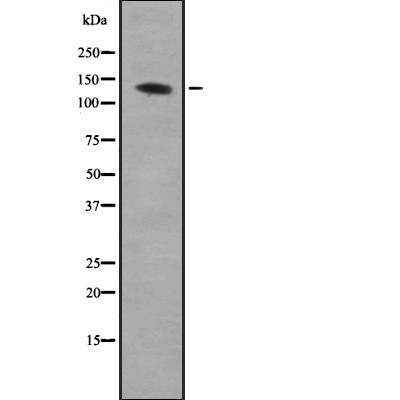AEBP1 Antibody - #DF2427
| Product: | AEBP1 Antibody |
| Catalog: | DF2427 |
| Description: | Rabbit polyclonal antibody to AEBP1 |
| Application: | WB IF/ICC |
| Reactivity: | Human, Mouse, Rat |
| Prediction: | Pig, Horse, Sheep, Rabbit, Dog, Xenopus |
| Mol.Wt.: | 130kDa; 131kD(Calculated). |
| Uniprot: | Q8IUX7 |
| RRID: | AB_2839633 |
Related Downloads
Protocols
Product Info
*The optimal dilutions should be determined by the end user.
*Tips:
WB: For western blot detection of denatured protein samples. IHC: For immunohistochemical detection of paraffin sections (IHC-p) or frozen sections (IHC-f) of tissue samples. IF/ICC: For immunofluorescence detection of cell samples. ELISA(peptide): For ELISA detection of antigenic peptide.
Cite Format: Affinity Biosciences Cat# DF2427, RRID:AB_2839633.
Immunogens
- Q8IUX7 AEBP1_HUMAN:
- Protein BLAST With
- NCBI/
- ExPASy/
- Uniprot
MAAVRGAPLLSCLLALLALCPGGRPQTVLTDDEIEEFLEGFLSELEPEPREDDVEAPPPPEPTPRVRKAQAGGKPGKRPGTAAEVPPEKTKDKGKKGKKDKGPKVPKESLEGSPRPPKKGKEKPPKATKKPKEKPPKATKKPKEKPPKATKKPKEKPPKATKKPPSGKRPPILAPSETLEWPLPPPPSPGPEELPQEGGAPLSNNWQNPGEETHVEAREHQPEPEEETEQPTLDYNDQIEREDYEDFEYIRRQKQPRPPPSRRRRPERVWPEPPEEKAPAPAPEERIEPPVKPLLPPLPPDYGDGYVIPNYDDMDYYFGPPPPQKPDAERQTDEEKEELKKPKKEDSSPKEETDKWAVEKGKDHKEPRKGEELEEEWTPTEKVKCPPIGMESHRIEDNQIRASSMLRHGLGAQRGRLNMQTGATEDDYYDGAWCAEDDARTQWIEVDTRRTTRFTGVITQGRDSSIHDDFVTTFFVGFSNDSQTWVMYTNGYEEMTFHGNVDKDTPVLSELPEPVVARFIRIYPLTWNGSLCMRLEVLGCSVAPVYSYYAQNEVVATDDLDFRHHSYKDMRQLMKVVNEECPTITRTYSLGKSSRGLKIYAMEISDNPGEHELGEPEFRYTAGIHGNEVLGRELLLLLMQYLCREYRDGNPRVRSLVQDTRIHLVPSLNPDGYEVAAQMGSEFGNWALGLWTEEGFDIFEDFPDLNSVLWGAEERKWVPYRVPNNNLPIPERYLSPDATVSTEVRAIIAWMEKNPFVLGANLNGGERLVSYPYDMARTPTQEQLLAAAMAAARGEDEDEVSEAQETPDHAIFRWLAISFASAHLTLTEPYRGGCQAQDYTGGMGIVNGAKWNPRTGTINDFSYLHTNCLELSFYLGCDKFPHESELPREWENNKEALLTFMEQVHRGIKGVVTDEQGIPIANATISVSGINHGVKTASGGDYWRILNPGEYRVTAHAEGYTPSAKTCNVDYDIGATQCNFILARSNWKRIREIMAMNGNRPIPHIDPSRPMTPQQRRLQQRRLQHRLRLRAQMRLRRLNATTTLGPHTVPPTLPPAPATTLSTTIEPWGLIPPTTAGWEESETETYTEVVTEFGTEVEPEFGTKVEPEFETQLEPEFETQLEPEFEEEEEEEKEEEIATGQAFPFTTVETYTVNFGDF
Predictions
Score>80(red) has high confidence and is suggested to be used for WB detection. *The prediction model is mainly based on the alignment of immunogen sequences, the results are for reference only, not as the basis of quality assurance.
High(score>80) Medium(80>score>50) Low(score<50) No confidence
PTMs - Q8IUX7 As Substrate
| Site | PTM Type | Enzyme | Source |
|---|---|---|---|
| K95 | Acetylation | Uniprot | |
| K96 | Acetylation | Uniprot | |
| S109 | Phosphorylation | Uniprot | |
| S113 | Phosphorylation | Uniprot | |
| K134 | Acetylation | Uniprot | |
| K137 | Acetylation | Uniprot | |
| K145 | Acetylation | Uniprot | |
| K148 | Acetylation | Uniprot | |
| K156 | Acetylation | Uniprot | |
| K159 | Acetylation | Uniprot | |
| T228 | Phosphorylation | Uniprot | |
| T232 | Phosphorylation | Uniprot | |
| S347 | Phosphorylation | Uniprot | |
| S404 | Phosphorylation | Uniprot | |
| Y429 | Phosphorylation | Uniprot | |
| N528 | N-Glycosylation | Uniprot | |
| K575 | Ubiquitination | Uniprot | |
| K592 | Ubiquitination | Uniprot | |
| K598 | Acetylation | Uniprot | |
| T621 | Phosphorylation | P28482 (MAPK1) | Uniprot |
| K716 | Ubiquitination | Uniprot | |
| K894 | Ubiquitination | Uniprot | |
| N922 | N-Glycosylation | Uniprot | |
| T1012 | Phosphorylation | P28482 (MAPK1) | Uniprot |
Research Backgrounds
As a positive regulator of collagen fibrillogenesis, it is probably involved in the organization and remodeling of the extracellular matrix.
May positively regulate MAP-kinase activity in adipocytes, leading to enhanced adipocyte proliferation and reduced adipocyte differentiation. May also positively regulate NF-kappa-B activity in macrophages by promoting the phosphorylation and subsequent degradation of I-kappa-B-alpha (NFKBIA), leading to enhanced macrophage inflammatory responsiveness. Can act as a transcriptional repressor.
Phosphorylated by MAPK1 in vitro.
Secreted.
Cytoplasm. Nucleus.
Expressed in osteoblast and visceral fat.
Isoform 1: Interacts with different types of collagen, including collagens I, III, and V. Isoform 2: Interacts with GNG5, NFKBIA, MAPK1, MAPK3 and PTEN. Interaction with MAPK1 may stimulate DNA-binding. May interact with calmodulin. Binds to DNA in vitro.
The F5/8 type C domain binds to different types of collagen, including collagens I, III, and V.
Belongs to the peptidase M14 family.
Restrictive clause
Affinity Biosciences tests all products strictly. Citations are provided as a resource for additional applications that have not been validated by Affinity Biosciences. Please choose the appropriate format for each application and consult Materials and Methods sections for additional details about the use of any product in these publications.
For Research Use Only.
Not for use in diagnostic or therapeutic procedures. Not for resale. Not for distribution without written consent. Affinity Biosciences will not be held responsible for patent infringement or other violations that may occur with the use of our products. Affinity Biosciences, Affinity Biosciences Logo and all other trademarks are the property of Affinity Biosciences LTD.

